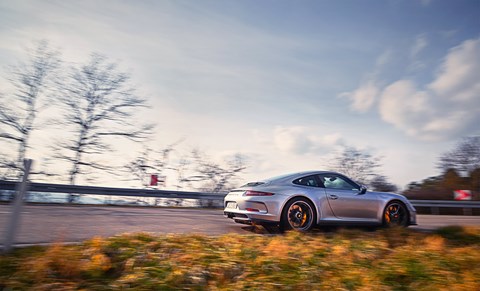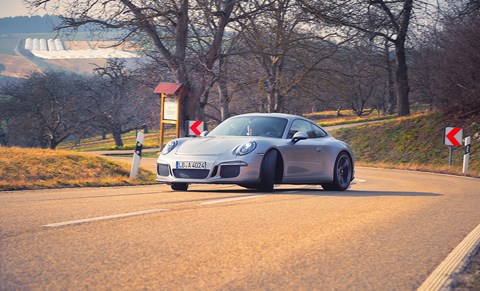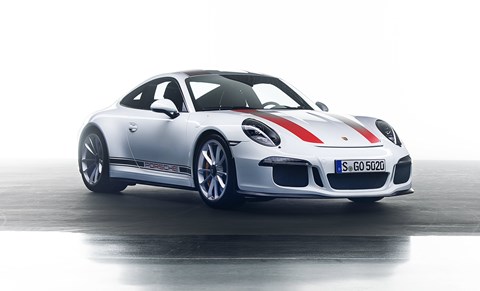► We take a look at the hardcore Porsche 911R
► Manual, naturally aspirated, 493bhp, RWD
► Effectively a GT3 without the aero kit
With the exception of a bunch of cheap runabouts and a few high-performance niche models, the normally aspirated engine is a dying breed. It has been overtaken by turbocharged motors which are, by design, more potent, torquier and more economical. So why is it that Porsche refuses to switch its most emotional products to artificial respiration?
‘Because there are clients who want to experience driving pleasure in its purest form,’ answers Andreas Preuninger, boss of Porsche’s GT division, without hesitation. ‘In more ways than one, the authentic, honest and transparent 911R fulfills the customers’ desire for absolute functionality. For me personally it is kind of a motorbike substitute for public roads, less so for track days.’ Well roared, lion!
Our car for the day is a virtually undisguised and unnumbered pre-production model. Painted GT silver, this understatement edition does without the full-volume Porsche lettering along the flanks and without the even louder full-length rallye stripes in either red or green. The warpaint was apparently inspired by the marque’s go-faster styling of the ’60s, as epitomised by the first 911R of 1967, powered by a 210bhp, 2.0-litre version of the flat-six.
The incognito livery pictured here matches the wolf-in-sheep’s-clothing character of the €189,544 (around £150,000) new 911R. While body and chassis were borrowed from the GT3, the R shares its lightweight panels (roof, wings, doors, windows) and big-block engine with the GT3 RS. Following the underdog theme of the original 1967 version (of which only 19 units were built), the 2016 911R features a mildly modified pop-up spoiler à la Carrera S instead of the fixed double-decker unique to the GT models. Together with the active wing, a diffuser integrated in the rear apron ensures handy downforce. Up front, the GT3’s aero kit promises zero lift.
Ready for action? A quick glance across to the passenger, a broad grin, a nod, and Preuninger reaches for the ignition key: we’re in business. The engine springs to life with a growl, takes a deep breath to 1500rpm, then emits a long pearly snarl, eventually settling at a restless idle. The firing order’s erratic like a faulty pacemaker, making itself heard through polyphonic gasps of intake slurp and the exhausts rapping in sync with the pulsating 493bhp flat-six. Even in neutral the gearlever rattles like a bunch of carnival ratchets. ‘These noises are too precious to be eliminated,’ smiles Preuninger. ‘Generated by the optional single-mass flywheel, they evoke emotions. In addition, the low-inertia device takes out five kilos in weight, and it further speeds up the ultra-quick throttle response. You don’t like it? Then simply disengage the clutch.’

The soundtrack of the R shouts 911, but with a twist. In this car, the legendary boxer plays a louder and more mechanical tune. Every throttle action has an instant effect on volume, bass, treble and balance. The acoustic highlight is the stereophonic gear-change process, which has such an in-cab presence you wouldn’t be surprised to learn that Porsche had installed a microphone in the engine bay and wired a speaker onto the firewall. Contributing musicians include humming ceramic brakes, a whistle of wind noise, a random underfloor poltergeist and the diff’s groaning, grinding monologue.
The engine’s distinctive aural presence is amplified by the lighter passenger cell, which has shed 25kg in weight along with the rear seats. At 1370kg, the 911R weighs 50kg less than the GT3 RS, and that’s with driver and a full tank of fuel. The dry weight is an equally impressive 1250kg.
Unlike his passenger, Andreas Preuninger is familiar with every corner, every crest and every fixed radar trap within a 30-mile radius of Porsche’s Weissach headquarters. Which partly explains the flat-out approach to several blind right-handers, one or two late-braking shocks, and the driver’s considerable trust in the still-cold Michelins. The car’s cornering prowess and stability through high-speed bends are absolutely phenomenal. While cerebrum and cerebellum are slapping one high-five after another, this wide-body animal just keeps building speed and grip, displaying minimal roll and no hint of surrender in the form of a slide.
The dampers are set in normal mode, the ESP warning light has yet to file an objection, and we’re still in fifth gear, pressing on down a long, long straight, trees strobing at a surreal rate. Even though every gearchange breaks the flow by inducing a momentary front-to-rear weight transfer, the 911R won’t alter its confidence-inspiring attitude as long as there is enough momentum to support progress. Its notoriously lairy predecessor was kneaded from a different dough.
ZF produces the new six-speed manual transmission Porsche has developed for the 911R and for the next GT3/GT3 RS, so there will soon be a choice between DIY and the outsourcing of services. Predictably, even the slickest and quickest shift artists cannot match the acceleration times of the PDK-equipped GT3 (3.5sec) and the GT3 RS (3.3sec). When revs, clutch action, tyre temperature and grip level work in unison, the R can sprint from 0-62mph in 3.8sec.
That’s bad for bragging but a real eye-opener when experienced unplugged and in Cinemascope. The reinforced clutch does a good job taming the restless flywheel, the shifter works with the fine mechanical precision of a high-end camera shutter and the eagerly staggered gear ratios have been chosen without a thought for CO2 emissions.According to its maker, the low-profile 493bhp 911 will average 21.2mpg. In this context worth noting that a full 68-litre tank improves the weight distribution from 38:62 to 40:60.
The brain takes time to acknowledge that the very physical cornering forces and time-warp stopping power this car can generate are controllable, not just angst on wheels. On nine out of ten roads the 911R holds a line with aplomb. Over the really rough stuff, however, the R eventually lays down its arms with a resigned slump that’s half rubber mattress, half pop rivet. But as soon as the earthquake surface begins to smooth again, and you can go faster than 40mph without kerbing a wheel or breaking a spring, the chassis reinstates that fundamental compliance, one that can only be neutralised by a premature stab of the damper button.

Beyond 70mph the adjustable suspension handles road-building lapses like sharp potholes, transverse ripples and frostbitten tarmac with deft skill. Even on such difficult terrain, the front end refrains from hopping and trembling, the steering won’t sashay around the straight-ahead, and the aerodynamic stability helps quash undue body movements before they even start. This inherent tautness spreads from C-road roughness all the way to table-top smoothness.
Although the virginal silver coupe has less than 100 miles on the clock, the chief project engineer clearly does not want to be a party pooper. So he hits the Sport+ symbol, keeps the ESP/PSM button pushed for more than eight seconds, and his mirrors and seatbelt once again. One hopes that Herr Preuninger knows the upcoming esses like the back of his hand, because the approach speed feels ambitious, his braking point at least two car lengths too optimistic, and the turn-in is so radically fast that we are bound to run out of front-end grip.
Or not. The bite reflex of the 245/35 ZR20 Michelins is supernaturally reliable, and the cornering balance built into the bespoke suspension pays off once again. Overdo things though and that dreaded counter-swing may kick the car off course for good, no matter how hard the diff is trying to set things straight again… When the 339lb ft of maximum torque takes its gloves off, even the extra-wide 305/30 ZR20 tyres will duly smear sideways.
The rear-wheel steering encourages quick changes of direction, and it helps plot a stable line at speed. At the limit of adhesion, it’s the job of sticky rubber and the talented chassis to distribute all that oomph in the most effective manner. Assistance is provided by ASR, ESP and the mechanical locking diff, which feels edgier but more effective than most electronically controlled systems.
In Sport+, stability control is more willing to turn a blind eye to an impending loss of traction, and the shock absorbers don’t absorb shocks quite as thoroughly anymore. Your neighbours will definitely hate the switchable and super-light titanium exhaust, which barks with an intensity that makes window panes tremble. The artificially generated on-demand throttle blipping, which precedes downshifts in the best heel-and-toe fashion, sounds hushed by comparison.

The 911R is fast, emotional, involving and extreme. But its prime virtue is the shotgun responsiveness, the almost telepathic reaction to orders from throttle, brakes and steering. When, without warning, Preuninger floors the accelerator at 4000rpm in second gear, this unassuming passenger gets his head slammed into the seatback, feels his legs become almost weightless for a second or two and watches as his own torso freezes in a mix of momentary immobility and total bafflement.
The (ironically) turbo-style kick produced by this remarkable naturally aspirated engine lets up ever so slightly at 7000rpm, just 1500rpm before the limiter cuts in. Born in the motorsport department, the four-litre six is addicted to revs. Peak power is delivered at 8250rpm; peak torque at 6250rpm. Even in fifth and sixth gears, the dynamo-like urge continues almost undimmed, the limiting factor your resolve to keep the accelerator pedal pushed to the floor.
‘The 911R combines the best of both worlds,’ claims Andreas Preuninger. ‘It’s a high-revving low-inertia powerhouse, but at the same time it picks up revs in a tall gear with explosive exertion. Which is another way of saying that you may shift down a notch whenever you feel like it, but there is rarely a real need to do so. This car can be raucous or refined, just take your pick.’ The 24-valve über-boxer draws the line between the two traits at about 4500rpm. Below that threshold it feels almost like a laissez-faire V8.
Above it, you better brace yourself for an unreal push which combines the zest of an afterburner with the long legs of a gas turbine. The 4.0-litre effortlessly spans extremes with a relentless energy the modern turbocharged 3.0-litre unit, though impressive, can only dream of. It’s the perfect engine for this hooligan car in disguise, one that is as minimalist inside as its pared-back exterior appearance would suggest. On the autobahn, the more slippery R eclipses even the two sold-out batmobiles: at 202mph, it has the edge over the 194mph GT3 and the 197mph GT3 RS.
Only 991 examples of the R will be made, and those lucky buyers can choose from three different body colours – white, red or black – and between a black or a brown cabin trim. Standard equipment includes 918-style buckets with traditional pepita cloth upholstery, bespoke green instrument faces and carbonfibre dashboard elements. Air conditioning and infotainment are no-cost options. Extra money buys a hydraulic front axle lift (dispensable, since the R uses the less vulnerable GT3 nasal air dam), a more elaborate finish for the knock-off lightweight wheels, full leather trim and said single-mass flywheel.
A select few vehicles can be channelled through the Exclusive division, but since the R is the last of the pre-facelift models, the production schedule is extremely tight. According to Weissach sources, the next GT3 is due in 2017, followed by a new GT3 RS in 2018 and a still-to-be-defined 911R replacement the year after. Although all three models will again be available only in limited numbers, this time we can at least give you three years’ advance warning. Use it wisely.

Porsche 911R decoded
- Body and chassis from 911 GT3.
- Wider, more aggressive shape and aero from road homologated clubsport racer, including front spoiler and rear diffuser.
- Inspiration/decals from 1967 911R.
- Only 19 were built for homologation, featuring 210bhp flat-six and distinctive Porsche decals.
- Seats from 918.
- R snaffles the supercar’s pepita cloth buckets.
- Lightweight panels/engine from 911 GT3 RS.
- Roof, wings and doors are carbonfibre, side and rear windows polycarbonate.
- Engine in same 493bhp tune as GT3 RS.
- Rear spoiler from 911 Carrera S.
- R gets mildly modified pop-up wing instead of GT3’s fixed double-decker item.
The specs: Porsche 911R
Price: £150,000
Engine: 3996cc 24v flat-six, 493bhp @ 8250rpm, 339lb ft @ 6250rpm
Transmission: Six-speed manual, rear-wheel drive
Suspension: MacPherson strut front, multi-link rear
Performance: 3.8sec 0-62mph, 202mph, 21.2mpg, 295g/km CO2 (est)
Weight/made from: 1370kg/steel and carbonfibre
Length/width/height: 4545/1880/1291mm
On sale: Sold out!
Read more from the April 2016 issue of CAR magazine